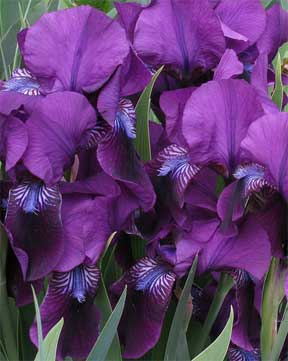Iris comes in many sizes and flavors. Here’s a quick round up to help you find the best for your landscape or flower garden.
Dwarf Bearded Iris
Heralding the iris season in earliest spring – late April and early May in the Northeastern states are the dwarf bearded varieties.
Appearance: Growing only 4 to 9 inches high, these varieties of Iris pumila are perfect miniatures of their tall bearded relatives. Outstanding dwarf bearded varieties come in white, red, light yellow, red-purple and others. Some intermediate varieties growing to 18 inches and bloom in fall as well as early spring.

Culture: Order early so rhizomes can be planted in midsummer and be well established before fall frosts. Buy only a few of each variety, for one rhizome will, in a few years, be a good sized clump. Choose a sunny spot with well drained soil. When planting, just barely cover the rhizome with soil.
Place in the landscape: As broad masses of color in the rockery, dwarf bearded iris are especially effective. They also make a fine ribbon edging for a border.
Bulbous Iris
When the earliest crocus ushers in the spring, Iris reticulata, one of the bulbous iris, also comes into bloom. Following are the other bulbous iris, the Dutch, the Spanish and the English.
Appearance: A Dutch iris in miniature, I. reticulata grows only 4 inches high. The Dutch, Spanish and English iris grow to 2 feet. It is a Dutch iris, available in blue, white and yellow, that is sold by many florist. Spanish iris are similar but smaller. English iris come in the same colors (except yellow) and are stouter.
Culture: Bulbous iris are not widely available, so buy from an iris specialist. Plant in late summer, covering bulbs with 3 inches of soil. English iris prefer a cool, acid, moist soil; Dutch and Spanish iris, a warm, light soil. The latter also need winter protection.
Place in the landscape: Mass I. reticulata against an interesting background such as a low, sweeping evergreen. The taller bulbous iris can be grouped at the back of the border.
Japanese Iris
The procession of iris bloom is extended well into July by Japanese iris.
Appearance: These beardless iris are spectacular, their 8 to 11-inch, widely flaring blooms crowning 4-foot plants. The long, tapering foliage tumbling gracefully, is also attractive. Single and double-flowering varieties are available in white, lavender pink, blue and purple.
Culture: Order early fall or early spring planting. Japanese iris do not tolerate lime. They need abundant moisture, particularly before and during blooming. The bank of a stream is an ideal planting spot. However. they can be grown in the border if they are watered often before blooming. Afterwards they need no more water than other perennials. Plant rhizomes in full sun, covering with 2 inches of soil.
Place in the landscape: Group plants for color accents in the perennial border, along a stream, beside a pool.
Tall Bearded Iris
Most popular of all iris are the tall bearded, blooming in the Northeast from early May until mid-June.
Appearance: As a result of intensive breeding, today’s tall bearded iris vary widely. Some are heavily ruffled and crimped, others neatly tailored and smooth; some have a velvety texture, others a crisp, silvery sheen. Colors vary also, there being blends. bicolors and uniform selfs. Newest shades are pink, near-black and mahogany. Also there are the ever-popular yellows, whites, blues and purples.
Culture: Nurseries, garden centers and mail-order nurserymen sell tall bearded iris, but the iris specialists usually carry the widest selection. Planting is done in middle and late summer.
Place in the landscape: Accent architectural features such as a bench or lamp post with clumps of iris. Make groupings in the perennial border.
Louisiana Iris
The Louisiana iris make their contribution in ilowering after the tall bearded iris and in growing where the latter find it diflicult to survive.
Appearance: The 5 t o 8-inch blooms, graceful foliage and splendid color range, including vivid reds, copper, pink, blue, purple, bright yellow and white, make Louisiana iris hard to resist.
Culture: Surprisingly hardy, modern varieties developed from native Louisiana species thrive in the Northern states and southern Canada. Though they prefer abundant moisture and would be ideally located beside a pool, Louisiana iris can also be grown with other perennials in the garden if supplied with water. Plant in a sunny spot, just barely covering the rhizomes with soil.
Place in the landscape: Naturalize Louisiana iris along the edges of a pool or stream. Group clumps as color accents in the perennial border.
Siberian Iris
The value of Siberian iris lies in their ability to flourish where other perennials grow and in the coldest climates. They can be grown in mild climates but where winters are cold they perform best. They bloom with the bearded iris.
Appearance: Though their blooms in white, purple or blue are not as dazzling as those of the tall bearded iris, their lightness and grace are an asset.
Culture: Planting is best done in late sum1ner or early autumn. They must have sun; though they prefer abundant moisture, they will thrive when grown under the same conditions as other garden perennials. The clump will reach its peak performance only if left undisturbed for years.
Place in the landscape: Add clumps of Siberian iris to the middle of the perennial border for a light, airy effect. Where summers are dry, plant Siberian iris along the edge of the garden within reach of the lawn sprinkler.
